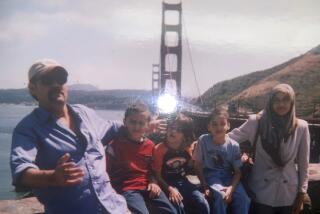U.S. Contemplated Rescue Missions for Hostages but Had to Stop Short : Mideast: Intelligence agencies located captives at least three times. But they lacked enough details to attempt the operation.
- Share via
WASHINGTON — U.S. intelligence agencies knew where American hostages were being held in Lebanon at least three times during the last seven years, but never had enough detailed information to make a rescue mission feasible, current and former officials said Thursday.
Hostages were spotted at times in an apartment building in Beirut, in a military barracks in eastern Lebanon’s Bekaa Valley and near the southern city of Tyre, the officials said. But in each instance, rescue turned out to be impossible--often because the hostages were moved before such a mission could be planned.
“We put a lot of effort into trying to find these guys,” said L. Paul Bremer, a former counterterrorism chief at the State Department. “Sometimes we did find them, . . . but we didn’t have it in sufficient detail to use it operationally. It’s not enough to know what building they’re in, what floor, what apartment or even what room. You’ve got to know which way the door opens and where the guard sleeps. That kind of intelligence we just never had.”
That was one of several lessons the hostage crisis brought home for policy-makers: A rescue mission may be a tempting idea but it can only work under very special circumstances.
The Reagan Administration seriously considered a rescue mission in 1986, and officials--including White House aide Oliver L. North, who later became a key figure in the Iran-Contra scandal--had a detailed model built of a Beirut neighborhood where the hostages were believed to be. But after long argument, it turned out that at least some of the hostages were not there after all, recalled Robert B. Oakley, then a counterterrorism specialist at the National Security Council.
“We thought they were in one place, and it turned out they weren’t . . .,” he said. “Even if we had good information as of a week or 10 days ago, that didn’t mean the information was still good.”
This week, accounts from Terry A. Anderson and other newly released hostages have provided U.S. intelligence with more details on where the captives were held and have confirmed that they were moved frequently--”almost continuously,” one official said.
“The intelligence guys will have a field day,” said Bremer, “making charts of who was held by whom and where and when.”
Some hostages who were released earlier have also made public new details that they once kept secret. Former hostage Frank H. Reed has said he was imprisoned in the basement of a house in southern Lebanon. Robert Polhill recalled being kept in a barn.
And Thomas M. Sutherland pinpointed a building on the Mediterranean coast highway just west of Beirut International Airport.
They also provided some new details about their captors. “They seemed to have unlimited amounts of money,” Thomas M. Sutherland said on ABC-TV’s “Nightline.” “They drove around in Mercedes-Benz cars. They had color television sets. . . . They had TV monitors to keep track of us in the rooms.”
The hostages’ accounts have also bolstered the argument of some analysts that the terrorists who proclaimed themselves members of several different groups were actually part of a single organization.
The capture of some of the hostages, such as Anderson, was announced by a group calling itself Islamic Jihad (Islamic Holy War). Others were reported by groups using other names.
But several hostages who were purportedly held by one group have reported that they shared cells or at least crossed paths with hostages held by another--suggesting that the various groups were either a single organization or closely linked.
And the role played by Iran in gaining their release has convinced many officials that the Tehran government had more power over the captors than it previously admitted. “They were, as we believed, held by different groups under a single umbrella,” a U.S. official said. “But in the last year, Iran moved in and took a more active role . . . and they were brought together.”
“It’s a puzzle that was being completed slowly,” he added. “We built on it every time we talked to a released hostage.”
U.S. intelligence faced one more problem in its search for the hostages: much of the information it was receiving turned out to be false.
More to Read
Sign up for Essential California
The most important California stories and recommendations in your inbox every morning.
You may occasionally receive promotional content from the Los Angeles Times.














